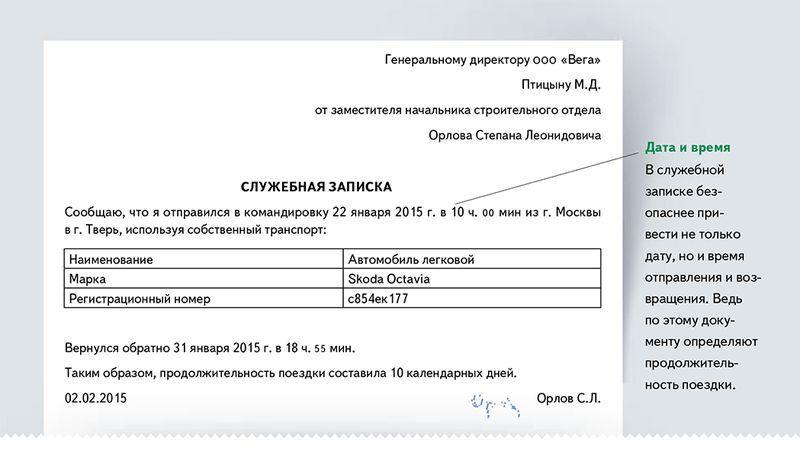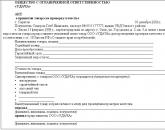How to write a memo for an employee: an example
At any job, the bulk of internal circulation documents are various kinds of service or memorandums, explanatory and other documents. Often, a misunderstanding of the difference between these documents leads to incorrect office work, especially if the start-up company does not have employees with sufficient experience in this area. In order for the “paperwork” not to become a heavy burden, but, on the contrary, to help in doing business, you need to deal with the differences in the documents. Let us dwell on the most frequently used and demanded document - a memo.
A memo is necessary for any enterprise - private or public. With the help of it, the heads of single-order structural divisions, employees who conduct their range of affairs and have specific responsibilities can communicate with each other. The purpose of this document is to notify the other party of the current situation and the need to make a business decision.
Note: as a rule, the service is not of an administrative nature, which means that the request set out in the service note is not binding.
However, ignoring them and answering them with refusals is also not recommended. The exception is those documents that contain information for review, and the second party should not make any decisions, but only read the content of the text.
Service is one of the most common ways of interaction between employees of the enterprise and its superiors.
Features of compiling a memo
The difficulties in compiling these papers are not unreasonable, because the rules for writing memos in office work are not clearly defined. Of course, most books on office work will contain recommendations for the preparation of such documents. However, it is unlikely that a single sample will be found - each edition will advise its own sample, different from another book. This causes bewilderment among employees who are faced with the need to write paper.
To understand the specifics of a memo, let's name some of the features of this document:
- the document most often encourages the other party to act. As a rule, we are talking about the need to make business decisions on some issues;
- the paper should display those issues that cannot be resolved orally, as well as those that need to be documented. You shouldn't create a document if it doesn't address the question you're asking in any way;
- the text can not only encourage the solution of a business issue, but also be purely informative, explanatory in nature. For example, this may be additional information on a previously submitted request, an updated task for a structural unit; request or proposal for joint activities of two structural departments, etc.;
- it is worth noting that the paper involves communication between the heads of equivalent structural units that can communicate at the same level. A memo is not created for their subordinates, nor is it formed for top management, from which the unit is separated by several hierarchical steps;
- the text should reflect the issues that are within the competence of the second party. A classic example of how a memo is written is an application addressed to the director, from whom you are waiting for a solution to the issue of your unit;
- the document in its essence can be of three types: informative, reporting, prompting a decision. Do not mix all three types in one document. As a rule, this leads to a pile of unnecessary facts, among which it is difficult to single out the essence of the document;
If the paper inherently requires an extended presentation of information, then in this case it is necessary to adhere to the main points of the presentation of the material:
- a description of the reasons that prompted the creation of the document;
- analysis of the situation, which leads to the idea of the need to resolve the issue by the second party;
- specific proposals to address this issue.
Mandatory details of a memo
Despite the fact that a single note form in office work has not yet been developed, there are certain rules for compiling such documents. An example of compiling a memo to the second party can be seen in the following illustration.

As seen in the example shown, The memo must contain the following items:
- the addressee to whom the paper was sent, indicating the position, surname and initials;
- the document type and its outgoing number are indicated according to the current list;
- a statement of the essence of the memo, a description of the problem that needs to be solved, or information that should be taken into account;
- a proposal to resolve the issue that the submitting party sees;
- date of submission of the document, signature of the head of the structural unit;
- contacts, surname and initials of the person who can be contacted to resolve this issue.
Rules for issuing a memo
As a rule, the document is created on a computer in the .doc format. The initials of the second side are written in the upper right corner, all lines must be left aligned. An example of how to write a memo to a manager correctly can be created in the form of a letterhead if such notes are written often. The words "memo" are placed in the center of the sheet. A dot is placed after the words "memo", since this is the word that is considered the end of the sentence.
Next, from the paragraph is a statement of the essence of the document. Proposals for resolving the issue are submitted from a new line, also from a paragraph. The date of creation of the document is indicated in the left corner below, and the signature of the official is placed in the right corner.
A little lower than the date, contacts and data of the person authorized to take further actions on the essence of the memo are indicated. This may be the contact of the head of the unit, or another official who is entrusted with resolving the issue.
All text is typed in Times New Roman, as the most commonly used font in office work, size 14.
Note: indents on all sides are not strictly regulated, however, they must be at least one and a half centimeters on each side. This is to ensure that the paper is filed into the appropriate internal documentation folder.

Memos can be written by hand, but the printed version typed on a PC is most often practiced.
Features of filing a memo
Memos were previously submitted in physical form in two copies. One of them is dated and signed by the person who accepted the document. This may be a secretary, an assistant to the head of a unit, or another official authorized to receive such documents. The second copy of the document remains in the structural unit in case the paper is lost, or the statute of limitations for resolving the issue expires. Only if you have a second copy of the memo can you prove the fact of your appeal to the second party.
The originals are either an assistant, or a secretary, or the head of the unit personally. Some memos are better coordinated with other structural divisions. For example, if you don’t know how to write a memo for an employee, you can download a sample of a disciplinary sanction from software or ask for it in the personnel department. However, this method of transferring papers is currently not used in many companies. Most organizations have switched to electronic document management.
If you have a working e-mail box, the paper can be transferred via the Internet. At the same time, the recommendations for registration remain the same, the only innovation is the indication of the last name and initials of the second party in the e-mail, the subject of the letter must be marked “memo”, and in the body of the letter - a request for confirmation of receipt of the attachment to the letter. In this case, the outgoing letter with the date and time of departure will be the confirming moment. The acceptance of the paper will be evidenced by a response letter that has arrived at the unit.
Popular
- How to get a TIN: possible ways
- What kind of business can you do?
- Written notice of termination of the lease
- Business from scratch. Things to do?
- Cost of goods sold: formula, methodology and calculation example
- How to write a vacation application - examples
- What kind of business can be opened in a small town or village?
- The formula for calculating the cost of services, products sold and total cost
- Sample memorandum: I bring to your attention
- Example of an explanatory note for being late for work




